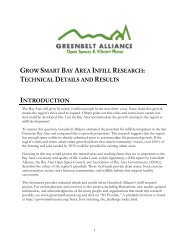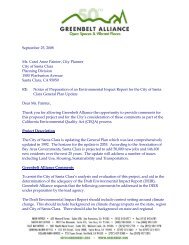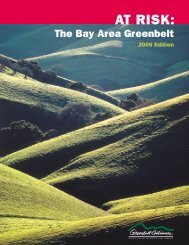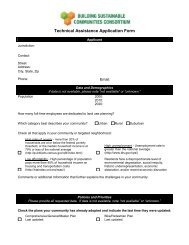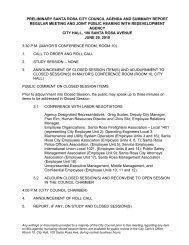Morgan Hill Agricultural Policies and Implementation Program
Morgan Hill Agricultural Policies and Implementation Program
Morgan Hill Agricultural Policies and Implementation Program
Create successful ePaper yourself
Turn your PDF publications into a flip-book with our unique Google optimized e-Paper software.
APPENDIX B: AGRICULTURAL CONSERVATION EASEMENTS<br />
Obtaining agricultural conservation easements—whether through dedication, donation, or purchase—<br />
generally provides the best opportunity to preserve l<strong>and</strong> for agricultural use, while also allowing<br />
farmers to continue their operations unimpeded. An easement is defined as “an interest in real<br />
property that conveys use but not ownership of a portion of an owner's property”. 1 An agricultural<br />
conservation easement is a specific type of easement whose purpose is to enable the encumbered<br />
property to remain in productive agricultural use by preventing any use or activity that would<br />
diminish or impair the agriculturally productive capacity <strong>and</strong> open-space character of the property.<br />
Therefore, the terms of an agricultural-conservation easement restrict the use of the encumbered<br />
property to agriculture, while prohibiting development, subdivision, <strong>and</strong> commercial use of the<br />
property other than as agriculture. 2 <strong>Agricultural</strong> conservation easements are perpetual, running with<br />
the l<strong>and</strong> so that their terms are binding on all future fee-title owners of the property. 3<br />
It is recommended that the City adopt an <strong>Agricultural</strong> Conservation Easement (ACE) program as a<br />
core component of its agricultural l<strong>and</strong> preservation program. The City or agricultural preservation<br />
partners, would obtain agricultural conservation easements through one of three methods:<br />
dedication, purchase, or donation. Regardless of whether an agricultural conservation easement is<br />
acquired by a developer <strong>and</strong> then dedicated or directly purchased by the City or partner<br />
agency/entity, all easements will be purchased from willing sellers only. In some cases, l<strong>and</strong> may be<br />
purchased in fee title (i.e., complete ownership of the l<strong>and</strong>), where l<strong>and</strong>owners are only interested in<br />
a fee-title sale. In these cases, the City or partner entity will place an easement over the l<strong>and</strong>, then,<br />
if feasible, sell or lease the restricted l<strong>and</strong> to interested farmers.<br />
Recommended actions associated with the pursuit of agricultural conservation easements include:<br />
• Outreach. As part of its outreach efforts, the City should conduct specific outreach to farmers<br />
<strong>and</strong> l<strong>and</strong>owners concerning the ACE program <strong>and</strong> the financial advantages <strong>and</strong> use restrictions<br />
associated with an easement sale.<br />
1 Definition according to the Dictionary of Real Estate, third edition, by the Appraisal Institute.<br />
2 Typically, a homesite or building site is reserved, with restrictions on the number or size of structures<br />
permitted there, while structures are prohibited everywhere else. In some cases, multiple pre-existing<br />
legal lots are joined together under a single easement, creating a larger de facto unitary lot <strong>and</strong><br />
extinguishing existing homesite <strong>and</strong> subdivision entitlements.<br />
3 The California Farml<strong>and</strong> Conservancy <strong>Program</strong> of the California Department of Conservation publishes<br />
the CFCP Model Easement. <strong>Agricultural</strong> conservation easements, as discussed in this report, are assumed<br />
to be similar to the model easement.<br />
B-1 P:\19000s\19014<strong>Morgan</strong><strong>Hill</strong>\Report\MHAgReport_22Dec2011_Public_Review.doc




